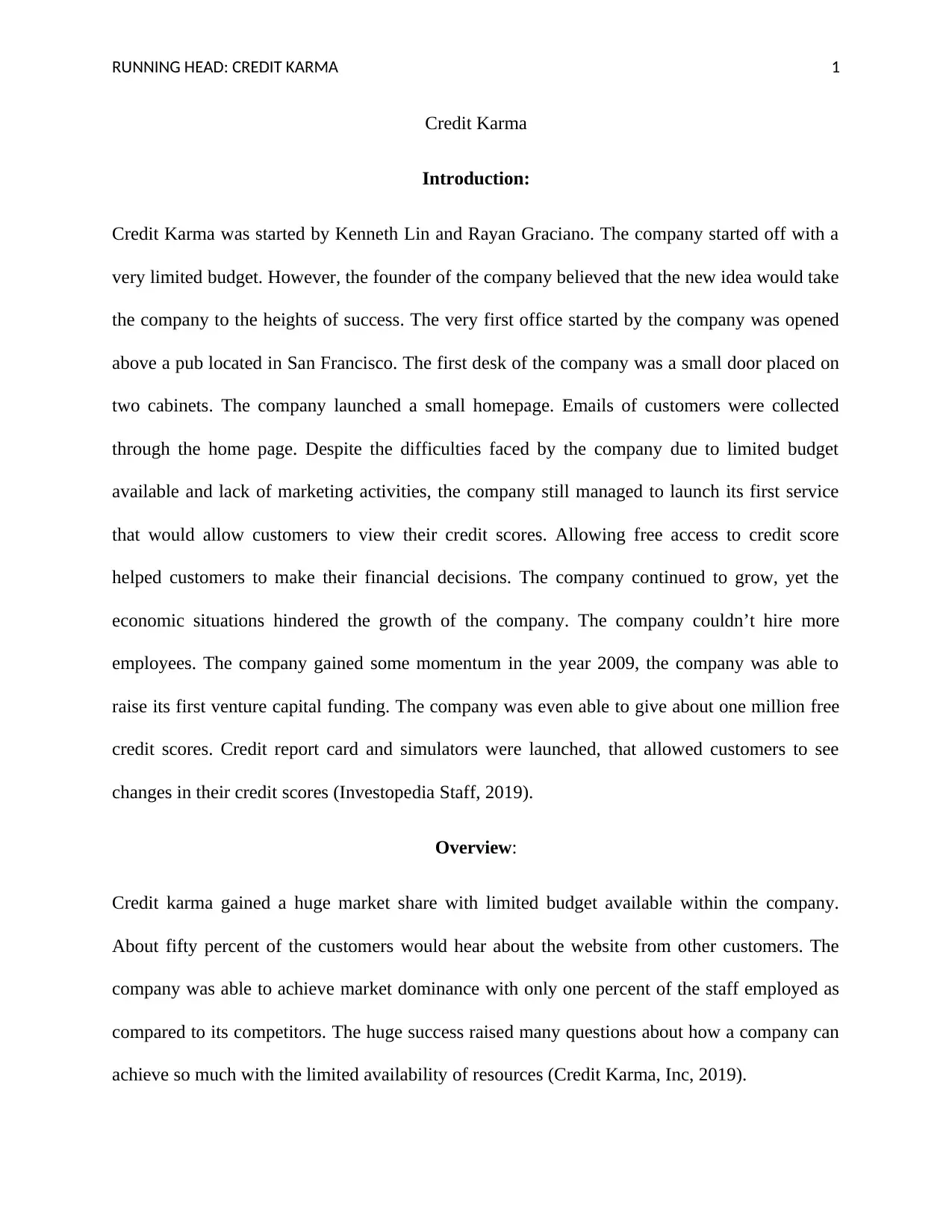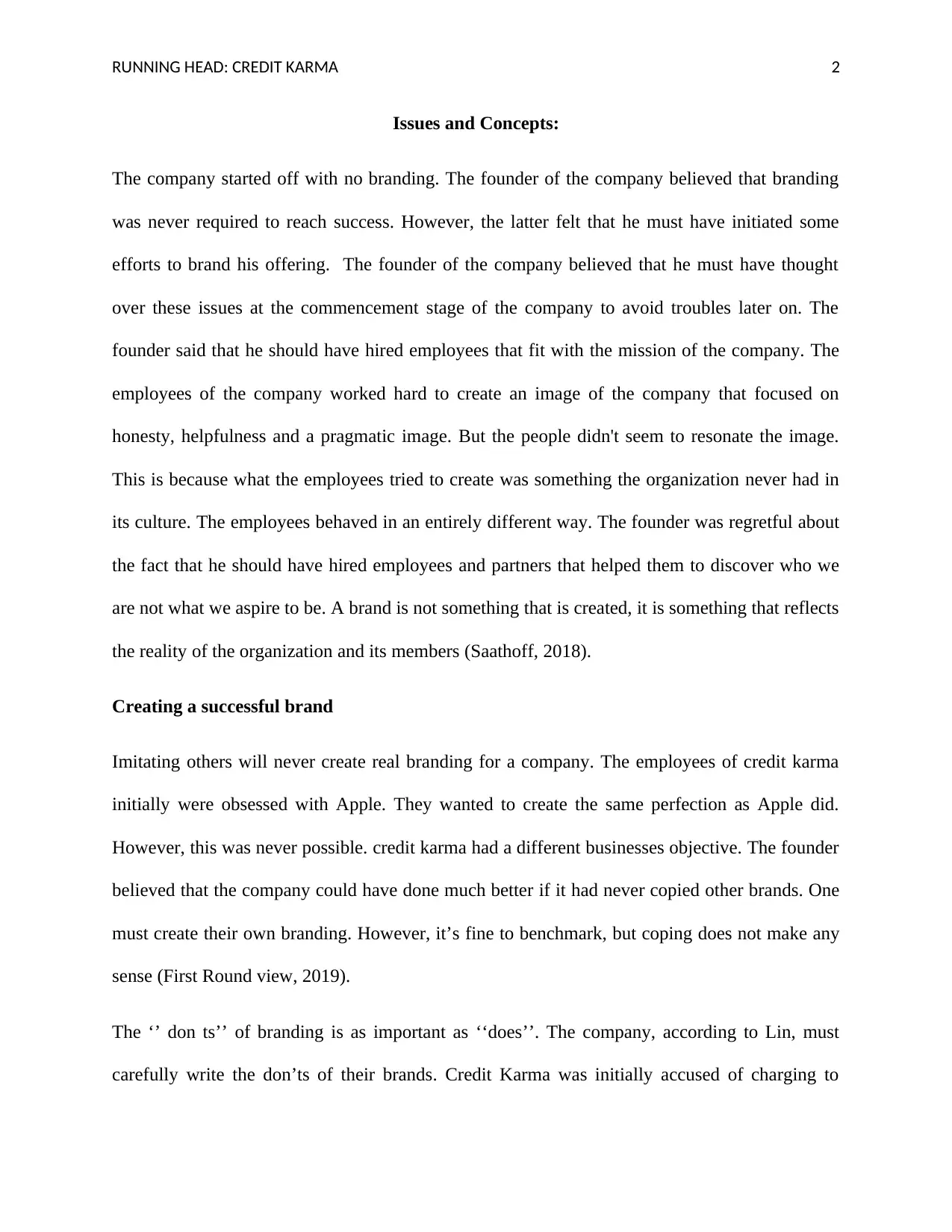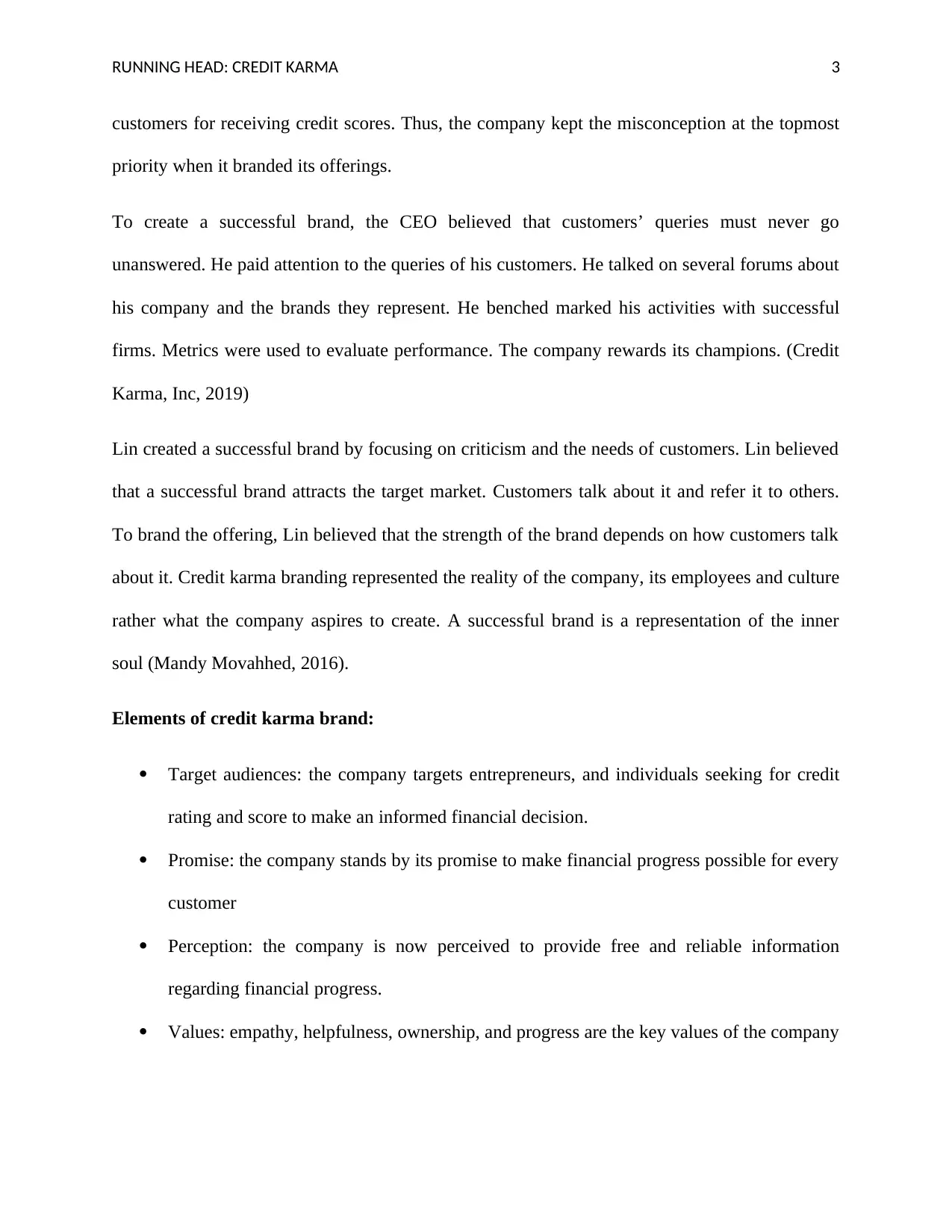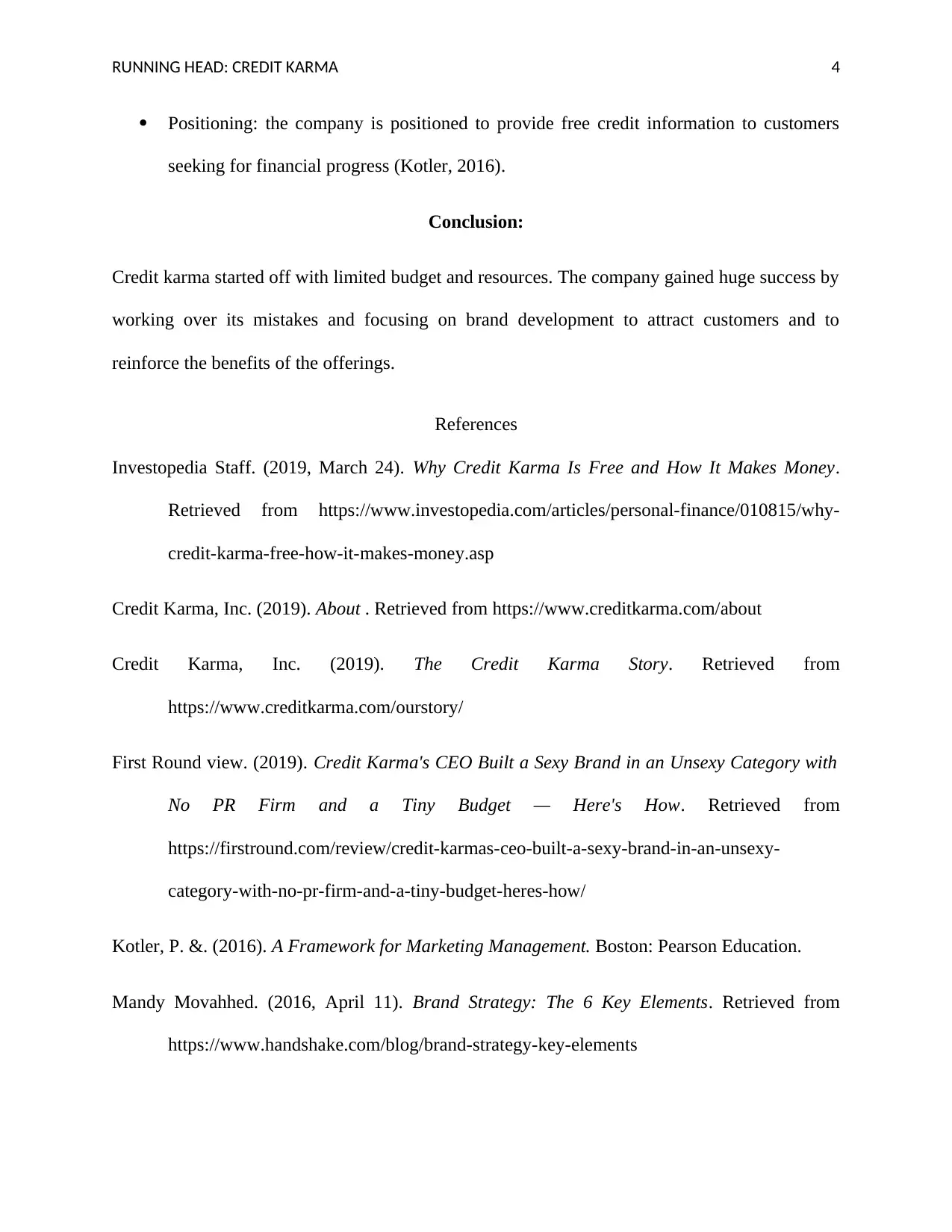Credit Karma: Branding, Business Strategy and Market Dominance Report
VerifiedAdded on 2023/01/17
|5
|1207
|58
Report
AI Summary
This report provides a detailed analysis of Credit Karma's branding and business strategy. It begins with an introduction to the company, founded by Kenneth Lin and Ryan Graciano, highlighting its humble beginnings and initial challenges, including limited resources and the launch of its first service offering free credit scores. The report then delves into the issues and concepts surrounding the company's branding efforts, discussing the founder's evolving views on the importance of branding, the pitfalls of imitation, and the significance of customer feedback. It explores key elements of Credit Karma's brand, including its target audience, promise, perception, values, and positioning, and concludes by emphasizing the company's focus on brand development to attract customers and reinforce the benefits of its offerings. The report references various sources, including Investopedia and Credit Karma's own publications, to support its findings.

RUNNING HEAD: CREDIT KARMA 1
Credit Karma
Introduction:
Credit Karma was started by Kenneth Lin and Rayan Graciano. The company started off with a
very limited budget. However, the founder of the company believed that the new idea would take
the company to the heights of success. The very first office started by the company was opened
above a pub located in San Francisco. The first desk of the company was a small door placed on
two cabinets. The company launched a small homepage. Emails of customers were collected
through the home page. Despite the difficulties faced by the company due to limited budget
available and lack of marketing activities, the company still managed to launch its first service
that would allow customers to view their credit scores. Allowing free access to credit score
helped customers to make their financial decisions. The company continued to grow, yet the
economic situations hindered the growth of the company. The company couldn’t hire more
employees. The company gained some momentum in the year 2009, the company was able to
raise its first venture capital funding. The company was even able to give about one million free
credit scores. Credit report card and simulators were launched, that allowed customers to see
changes in their credit scores (Investopedia Staff, 2019).
Overview:
Credit karma gained a huge market share with limited budget available within the company.
About fifty percent of the customers would hear about the website from other customers. The
company was able to achieve market dominance with only one percent of the staff employed as
compared to its competitors. The huge success raised many questions about how a company can
achieve so much with the limited availability of resources (Credit Karma, Inc, 2019).
Credit Karma
Introduction:
Credit Karma was started by Kenneth Lin and Rayan Graciano. The company started off with a
very limited budget. However, the founder of the company believed that the new idea would take
the company to the heights of success. The very first office started by the company was opened
above a pub located in San Francisco. The first desk of the company was a small door placed on
two cabinets. The company launched a small homepage. Emails of customers were collected
through the home page. Despite the difficulties faced by the company due to limited budget
available and lack of marketing activities, the company still managed to launch its first service
that would allow customers to view their credit scores. Allowing free access to credit score
helped customers to make their financial decisions. The company continued to grow, yet the
economic situations hindered the growth of the company. The company couldn’t hire more
employees. The company gained some momentum in the year 2009, the company was able to
raise its first venture capital funding. The company was even able to give about one million free
credit scores. Credit report card and simulators were launched, that allowed customers to see
changes in their credit scores (Investopedia Staff, 2019).
Overview:
Credit karma gained a huge market share with limited budget available within the company.
About fifty percent of the customers would hear about the website from other customers. The
company was able to achieve market dominance with only one percent of the staff employed as
compared to its competitors. The huge success raised many questions about how a company can
achieve so much with the limited availability of resources (Credit Karma, Inc, 2019).
Paraphrase This Document
Need a fresh take? Get an instant paraphrase of this document with our AI Paraphraser

RUNNING HEAD: CREDIT KARMA 2
Issues and Concepts:
The company started off with no branding. The founder of the company believed that branding
was never required to reach success. However, the latter felt that he must have initiated some
efforts to brand his offering. The founder of the company believed that he must have thought
over these issues at the commencement stage of the company to avoid troubles later on. The
founder said that he should have hired employees that fit with the mission of the company. The
employees of the company worked hard to create an image of the company that focused on
honesty, helpfulness and a pragmatic image. But the people didn't seem to resonate the image.
This is because what the employees tried to create was something the organization never had in
its culture. The employees behaved in an entirely different way. The founder was regretful about
the fact that he should have hired employees and partners that helped them to discover who we
are not what we aspire to be. A brand is not something that is created, it is something that reflects
the reality of the organization and its members (Saathoff, 2018).
Creating a successful brand
Imitating others will never create real branding for a company. The employees of credit karma
initially were obsessed with Apple. They wanted to create the same perfection as Apple did.
However, this was never possible. credit karma had a different businesses objective. The founder
believed that the company could have done much better if it had never copied other brands. One
must create their own branding. However, it’s fine to benchmark, but coping does not make any
sense (First Round view, 2019).
The ‘’ don ts’’ of branding is as important as ‘‘does’’. The company, according to Lin, must
carefully write the don’ts of their brands. Credit Karma was initially accused of charging to
Issues and Concepts:
The company started off with no branding. The founder of the company believed that branding
was never required to reach success. However, the latter felt that he must have initiated some
efforts to brand his offering. The founder of the company believed that he must have thought
over these issues at the commencement stage of the company to avoid troubles later on. The
founder said that he should have hired employees that fit with the mission of the company. The
employees of the company worked hard to create an image of the company that focused on
honesty, helpfulness and a pragmatic image. But the people didn't seem to resonate the image.
This is because what the employees tried to create was something the organization never had in
its culture. The employees behaved in an entirely different way. The founder was regretful about
the fact that he should have hired employees and partners that helped them to discover who we
are not what we aspire to be. A brand is not something that is created, it is something that reflects
the reality of the organization and its members (Saathoff, 2018).
Creating a successful brand
Imitating others will never create real branding for a company. The employees of credit karma
initially were obsessed with Apple. They wanted to create the same perfection as Apple did.
However, this was never possible. credit karma had a different businesses objective. The founder
believed that the company could have done much better if it had never copied other brands. One
must create their own branding. However, it’s fine to benchmark, but coping does not make any
sense (First Round view, 2019).
The ‘’ don ts’’ of branding is as important as ‘‘does’’. The company, according to Lin, must
carefully write the don’ts of their brands. Credit Karma was initially accused of charging to

RUNNING HEAD: CREDIT KARMA 3
customers for receiving credit scores. Thus, the company kept the misconception at the topmost
priority when it branded its offerings.
To create a successful brand, the CEO believed that customers’ queries must never go
unanswered. He paid attention to the queries of his customers. He talked on several forums about
his company and the brands they represent. He benched marked his activities with successful
firms. Metrics were used to evaluate performance. The company rewards its champions. (Credit
Karma, Inc, 2019)
Lin created a successful brand by focusing on criticism and the needs of customers. Lin believed
that a successful brand attracts the target market. Customers talk about it and refer it to others.
To brand the offering, Lin believed that the strength of the brand depends on how customers talk
about it. Credit karma branding represented the reality of the company, its employees and culture
rather what the company aspires to create. A successful brand is a representation of the inner
soul (Mandy Movahhed, 2016).
Elements of credit karma brand:
Target audiences: the company targets entrepreneurs, and individuals seeking for credit
rating and score to make an informed financial decision.
Promise: the company stands by its promise to make financial progress possible for every
customer
Perception: the company is now perceived to provide free and reliable information
regarding financial progress.
Values: empathy, helpfulness, ownership, and progress are the key values of the company
customers for receiving credit scores. Thus, the company kept the misconception at the topmost
priority when it branded its offerings.
To create a successful brand, the CEO believed that customers’ queries must never go
unanswered. He paid attention to the queries of his customers. He talked on several forums about
his company and the brands they represent. He benched marked his activities with successful
firms. Metrics were used to evaluate performance. The company rewards its champions. (Credit
Karma, Inc, 2019)
Lin created a successful brand by focusing on criticism and the needs of customers. Lin believed
that a successful brand attracts the target market. Customers talk about it and refer it to others.
To brand the offering, Lin believed that the strength of the brand depends on how customers talk
about it. Credit karma branding represented the reality of the company, its employees and culture
rather what the company aspires to create. A successful brand is a representation of the inner
soul (Mandy Movahhed, 2016).
Elements of credit karma brand:
Target audiences: the company targets entrepreneurs, and individuals seeking for credit
rating and score to make an informed financial decision.
Promise: the company stands by its promise to make financial progress possible for every
customer
Perception: the company is now perceived to provide free and reliable information
regarding financial progress.
Values: empathy, helpfulness, ownership, and progress are the key values of the company
⊘ This is a preview!⊘
Do you want full access?
Subscribe today to unlock all pages.

Trusted by 1+ million students worldwide

RUNNING HEAD: CREDIT KARMA 4
Positioning: the company is positioned to provide free credit information to customers
seeking for financial progress (Kotler, 2016).
Conclusion:
Credit karma started off with limited budget and resources. The company gained huge success by
working over its mistakes and focusing on brand development to attract customers and to
reinforce the benefits of the offerings.
References
Investopedia Staff. (2019, March 24). Why Credit Karma Is Free and How It Makes Money.
Retrieved from https://www.investopedia.com/articles/personal-finance/010815/why-
credit-karma-free-how-it-makes-money.asp
Credit Karma, Inc. (2019). About . Retrieved from https://www.creditkarma.com/about
Credit Karma, Inc. (2019). The Credit Karma Story. Retrieved from
https://www.creditkarma.com/ourstory/
First Round view. (2019). Credit Karma's CEO Built a Sexy Brand in an Unsexy Category with
No PR Firm and a Tiny Budget — Here's How. Retrieved from
https://firstround.com/review/credit-karmas-ceo-built-a-sexy-brand-in-an-unsexy-
category-with-no-pr-firm-and-a-tiny-budget-heres-how/
Kotler, P. &. (2016). A Framework for Marketing Management. Boston: Pearson Education.
Mandy Movahhed. (2016, April 11). Brand Strategy: The 6 Key Elements. Retrieved from
https://www.handshake.com/blog/brand-strategy-key-elements
Positioning: the company is positioned to provide free credit information to customers
seeking for financial progress (Kotler, 2016).
Conclusion:
Credit karma started off with limited budget and resources. The company gained huge success by
working over its mistakes and focusing on brand development to attract customers and to
reinforce the benefits of the offerings.
References
Investopedia Staff. (2019, March 24). Why Credit Karma Is Free and How It Makes Money.
Retrieved from https://www.investopedia.com/articles/personal-finance/010815/why-
credit-karma-free-how-it-makes-money.asp
Credit Karma, Inc. (2019). About . Retrieved from https://www.creditkarma.com/about
Credit Karma, Inc. (2019). The Credit Karma Story. Retrieved from
https://www.creditkarma.com/ourstory/
First Round view. (2019). Credit Karma's CEO Built a Sexy Brand in an Unsexy Category with
No PR Firm and a Tiny Budget — Here's How. Retrieved from
https://firstround.com/review/credit-karmas-ceo-built-a-sexy-brand-in-an-unsexy-
category-with-no-pr-firm-and-a-tiny-budget-heres-how/
Kotler, P. &. (2016). A Framework for Marketing Management. Boston: Pearson Education.
Mandy Movahhed. (2016, April 11). Brand Strategy: The 6 Key Elements. Retrieved from
https://www.handshake.com/blog/brand-strategy-key-elements
Paraphrase This Document
Need a fresh take? Get an instant paraphrase of this document with our AI Paraphraser

RUNNING HEAD: CREDIT KARMA 5
Saathoff, K. (2018, December 4). Credit Karma Guide to Business Credit Scores. Retrieved from
https://www.creditkarma.com/advice/i/credit-karma-guide-to-business-credit-scores/
Saathoff, K. (2018, December 4). Credit Karma Guide to Business Credit Scores. Retrieved from
https://www.creditkarma.com/advice/i/credit-karma-guide-to-business-credit-scores/
1 out of 5
Related Documents
Your All-in-One AI-Powered Toolkit for Academic Success.
+13062052269
info@desklib.com
Available 24*7 on WhatsApp / Email
![[object Object]](/_next/static/media/star-bottom.7253800d.svg)
Unlock your academic potential
Copyright © 2020–2025 A2Z Services. All Rights Reserved. Developed and managed by ZUCOL.





